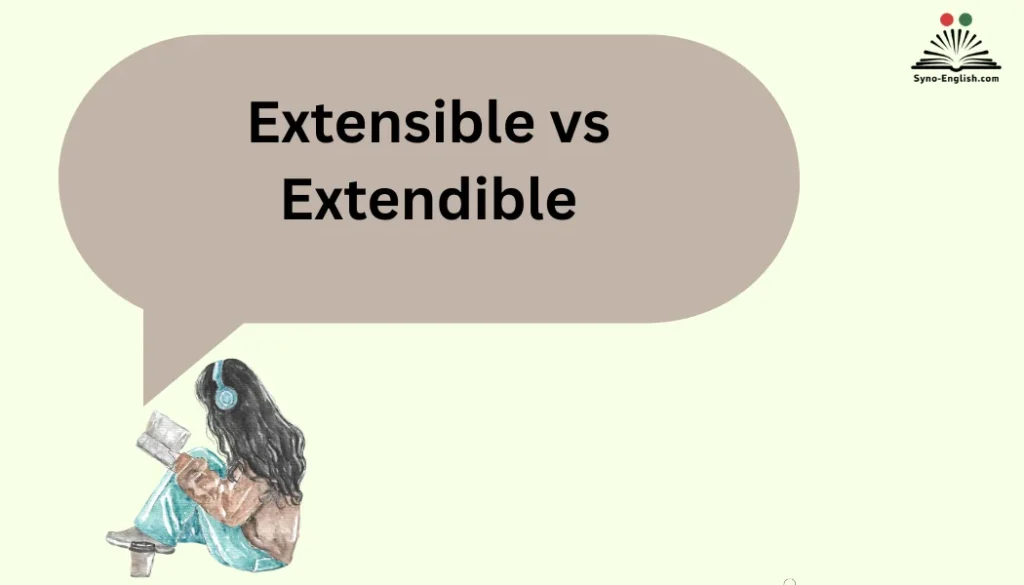When I first paused over my keyboard, deciding between extensible and extendible, it felt like choosing between two similar paths. The phrase Extensible vs Extendible often comes up when discussing technical writing or software documentation, where even a small difference in adjectives can change perception. The right word guides readers to understand the module, design, and overall clarity you aim for—building trust, authority, and lasting precision in every conversation.
Through real-world examples, I’ve found that language choice reflects professional etiquette, proving that words carry more weight than they seem.In the software world, a system architected for plugins is truly extensible, not merely extendible. The definitions trace origins to deeper linguistic roots—where extensible implies structured expandability, and extendible points to physical or conceptual lengthening.
This subtle distinction helps avoid misunderstandings in collaborative team discussions or project documentation. Each time I choose the right word, I notice how such nuances can affect design implications and influence decision-making in product planning, making language an integral part of building better systems.
Breaking Down the Definitions
Extensible: Growth by Design
“Extensible” describes something designed to accept new features or capacities without altering its core structure. It’s about adaptability, modular architecture, and future expansion. In software, extensibility is one of the pillars that enable sustainable systems.
Linguistically, it stems from Latin extendere (“to stretch out”), but in practice pays more attention to how future stretching is enabled.
Key traits of “extensible”
- You add new modules, plugins, or behaviors.
- The core remains intact — you don’t have to rip out large portions.
- It handles unanticipated growth.
Extendible: Physical or Explicit Extension
“Extendible” (sometimes spelled “extendable”) focuses on lengthening or making something physically bigger or longer — often via telescoping, sliding parts, or expansion. The idea is concrete, not metaphorical.
Examples:
- A telescoping ladder is extendible (you pull sections out).
- A dining table with leaves is extendible (you insert extra panels).
Often, dictionaries treat extendible and extensible as synonyms in broad terms. But technical and design contexts tease out meaningful differences.
How the Two Relate (and Overlap)
The boundary between them occasionally blurs. Something might be both “extendible” and “extensible,” depending on what aspect you’re highlighting: physical extension or future modular growth.
One widely accepted distinction:
- Use extensible when emphasizing capability to grow in new ways.
- Use extendible when emphasizing physical or explicit expansion.
Extensible in Action: Growth and Adaptability
Let’s see “extensible” in motion — where real systems allow evolution without rupture.
Software Plugins & APIs
Most browsers (Chrome, Firefox) are extensible: you install new extensions without modifying the browser core.
A well-architected CMS lets you add modules (shopping carts, analytics, SEO tools) without rewriting everything.
These systems expose “hooks,” interfaces, or extension points. Developers build add-ons that tap into those extension points. That’s the heart of extensible design.
Modular Systems & Microservices
Architecting a system as modules or microservices makes it extensible. You can build new features as separate services and connect them with APIs.
For example, in a remote care application built with microservices, new modules (e.g. sensor integration, notification workflows) were added without jeopardizing the base system. That architecture facilitated extensibility while preserving stability
Business Systems & Enterprise Platforms
Enterprise systems often need to adapt to custom business rules, region-specific modules, or vertical integrations. A well-designed ERP or CRM is extensible — it anticipates that businesses will demand new features.
Platforms like Strapi advertise “plugin architectures” so you can extend behavior without rewriting core logic.
Why Extensibility Matters
- Future-proofing: You won’t need to tear everything down when requirements shift.
- Cost savings: Adding small features is cheaper than major rewrites.
- Faster innovation: You can test, iterate, and plug in new ideas.
- Ecosystem growth: Developers build extensions, expanding your product organically.
But beware: more extensibility can open security and stability risks if not managed carefully. Extendible in Action: Objects That Expand
Now let’s turn to tangible, physical objects that embody “extendible.”
Telescoping Ladders
Sections slide in and out. You pull them longer (or collapse them). The mechanism is mechanical and concrete.
Expandable Dining Tables
Tables that take extra panels — you insert leaves, and the table gets longer.
Retractable Measuring Tapes
You pull out the tape; it retracts back. The tape is extendible.
Camera Tripods, Furniture & Tools
Legs that telescope, tools that expand via additional rods, beds that roll out, even some lean-in structures in architecture can be extendible.
These are real, physical expansions. The design focuses on how components slide, lock, unfold, or collapse.
Key Distinction: Extensible ≠ Extendible
Let’s place the two side by side to spot the difference clearly.
| Feature | Extensible | Extendible |
| Focus | Adding new behavior, capabilities, modules | Making something longer, larger, or physically extending |
| Domain | Abstract systems, software, business, architecture | Physical objects, machines, tools |
| Change method | Via interfaces, plugins, extension points | Via sliding parts, insertion, unfolding |
| Example | Browser supporting new plugins | Telescoping pole, expandable table |
When you confuse them, you risk miscommunication. Saying “an extensible ladder” mislabels mechanical expansion with modular growth intent.
Extensibility in Technology: Driving Innovation
In tech, extensibility is a heartbeat. Software must adapt, scale, evolve — and extensibility is the design lever that enables that.
Definition in Software Engineering
Software extensibility is the ability to add or modify features without altering existing code or disrupting core functionality.
It ensures that the system can grow in response to new requirements, integrations, or user needs.
Forms of Extensibility
- White-box extensibility: You can modify the source code itself.
- Gray-box extensibility: Partial exposure; you can use certain extension points or APIs without modifying deep internals.
- Black-box extensibility: Only interfaces or configuration tools are provided; you don’t see the internals.
Extensions happen purely via interface, scripting, or configuration.
Each form has trade-offs: openness, safety, maintainability.
Distinguishing Extensibility vs. Scalability
People often mix “scalable” and “extensible.” They are related but distinct:
- Scalability: How a system handles increased loads (users, data, traffic).
- Extensibility: How easily you can add features or change behavior.
A system might scale well but be rigid in features (poor extensibility), or be highly extensible but struggle with performance under load.
Real-World Examples in Software
- Managed Extensibility Framework (MEF): A Microsoft .NET mechanism enabling discovery and use of extensions dynamically, without heavy configuration.
- WordPress: Core remains stable; new plugins introduce features.
- Eclipse IDE: Its plugin architecture is a hallmark of software extensibility.
- APIs in SaaS platforms: Third parties can integrate without altering internals.
Design Patterns That Support Extensibility
- Dependency injection
- Strategy pattern / plugin architecture
Event handling / observer pattern - Service-oriented / modular architecture
- Abstract interfaces / extension points
These patterns separate concerns, keep the core clean, and guard against tight coupling.
Extendibility in Design and Tools
In product design, architecture, engineering — “extendible” principles surface in how objects grow or adapt physically.
Furniture for Compact Spaces
Bed frames that extend, folding desks, chairs with sliding components — all apply “extendible” design thinking.
Tools & Devices
Camera tripods with extendable legs, telescopic poles, extendible arms in robotics, deployable bridge segments.
Designers often balance strength, durability, locking mechanisms, materials, and usability when crafting these extendible features.
Structural & Mechanical Applications
In architecture and mechanical engineering, designs may include extendible supports or connectors. Think of retractable bridges, telescopic masts, or collapsible structures in aerospace.
Common Misconceptions and Overlaps
Even grammar experts disagree sometimes. Below are pitfalls to watch for.
Misconception: They’re Always Interchangeable
Many writers use “extendible” when meaning “extensible.” Context often disguises the error, but to rigorous readers it sticks out.
One StackExchange answer captures it:
“I use extensible when I mean that the functionality of something may be increased … My web browser is extensible … It would sound odd to call it extendable.
”Spelling Variation: Extendible vs Exten
dable
“Extendible” is a legitimate form; “extendable” is perhaps more frequent. Some style guides prefer extendable over extendible.
American vs British Preferences
Usage can lean differently by region, but you’ll often see “extensible” dominant in technical writing globally.
Choosing the Right Word: Practical Guidelines
When you write, ask these quick checks to pick “extensible” or “extendible”:
- Are you referring to adding new capabilities or modules? → extensible
- Are you referring to physical or explicit expansion? → extendible or extendable
Quick Reference Table
| Use Case | Recommended Term |
| A platform that can add plugin modules | extensible |
| A lamp arm that you stretch outward | extendible |
| Software that integrates with external APIs | extensible |
| A pull-out shelf | extendible |
| A system anticipating unknown future changes | extensible |
| A retractable measuring stick | extendible |
Examples (Corrected)
- The software is extensible, so developers can build new modules.
- The ladder is extendible, so you can pull it longer.
- The CMS is extensible, letting you add e-commerce without altering core.
- This desk is extendible — add panels to widen it.
By applying these distinctions, your writing becomes clearer, more authoritative, and less ambiguous.
Future Outlook: How These Concepts Evolve
Language and technology co-evolve. Here’s how these ideas may shift:
Language Drift Toward Convergence
Over time, usage may converge: “extensible” might absorb many “extendible” uses, particularly in digital contexts.
More Blended Products
As “smart” objects proliferate, physical items might combine both meanings: a smart ladder might be extendible in length and extensible in sensors or modules.
Extensibility in AI and Machine Learning
In AI, extensibility means new tasks or domains can be added without full retraining. Models will need to be extensible to adapt to new data and use cases.
Continued Emphasis in DevOps, APIs & Platforms
Platforms will double down on extensibility — more plugin ecosystems, sandboxed extensions, marketplaces of add-ons.
Case Studies: Extensible Systems in the Real World
MoveIt! Robotics Framework
MoveIt! is an open-source robotics software framework in ROS. It uses a plugin-based architecture so users can swap motion planners, sensor modules, kinematics libraries — all without rewriting core code.
Challenges and lessons:
- Too many plugins risk incompatibility
- Clear interface definitions are crucial
- Good documentation matters for extensibility adoption
Modular Statistical App (intRo)
In one academic project, developers built a modular statistics tool using Shiny modules. Each analysis tool was a self-contained module. Adding or removing functions became easy.
Lessons: consistent APIs, modular isolation, minimal coupling.
Remote Care System via Microservices
A remote health app used a microservice architecture to decouple functionality. New modules (device integrations, notification flows) plugged in without major rework.
This demonstrates how extensibility enables agile delivery in real, evolving systems.
Why Extensibility Fuels Innovation & Adaptability
Extensibility is not a buzzword — it’s a strategic asset.
- Faster iteration: You test, add, remove features easily.
- Reduced technical debt: You avoid monolithic rewrites.
- Ecosystem growth: Third parties build add-ons, strengthening the core.
- Customer empowerment: Clients customize systems to their needs.
- Longevity: Products evolve over years, not stagnate.
At the same time, guardrails must constrain how “free” an extensible system is. Without constraints, complexity, security gaps, or fragility creep in.
Common Mistakes & Pitfalls
- Overextending: Exposing too many extension points leads to unmanageable systems.
- Poor documentation: Extensions flounder without clear contracts and APIs.
- Tight coupling: If extension modules depend on internals, you break modularity.
- Security holes: Extensions can introduce vulnerabilities if unchecked.
Wrap your extensibility strategy with governance, versioning support, backward compatibility rules, and testing corridors
Conclusion
Understanding the distinction between extensible and extendible is more than a matter of semantics—it’s about using language with clarity, authority, and precision. In technical writing, documentation, and software architecture, every word contributes to the meaning and trust your readers place in you. When developers describe a system as extensible, they imply adaptability and structured scalability, while extendible leans toward physical or conceptual addition. Recognizing this difference ensures better communication, smoother collaboration, and stronger documentation practices that reflect true professional etiquette.
Over the years, professionals have realized that consistency in terminology enhances understanding and prevents misunderstandings in collaborative environments. The phrase Extensible vs Extendible serves as a reminder that words shape design implications and even influence product planning and decision-making. Whether crafting guidelines, teaching adjectives, or writing software documentation, precision is an essential habit, not a constraint. The ability to choose the right word confidently allows writers and developers alike to convey intent effectively, build credibility, and foster meaningful communication. Mastering this subtlety bridges the gap between technical expertise and linguistic excellence.
FAQs
What is the main difference between extensible and extendible?
Extensible refers to something designed to be expanded or enhanced structurally, while extendible relates to something that can be physically or conceptually lengthened.
Why does the distinction matter in technical writing?
Because precise terminology enhances clarity and prevents confusion in documentation and communication among professionals.
Which term is more common in software contexts?
Extensible is more common because it describes systems built to support plugins, modules, or future updates.
Can both words be used interchangeably?
They often are, but doing so can cause misunderstanding, especially in professional or technical contexts.
What are examples of extensible software systems?
Examples include browsers like Chrome or applications with plugin-based architectures that allow feature expansion.
Why do readers trust precise terminology?
Because clear language builds confidence in the writer’s knowledge, expertise, and attention to detail.
How can writers avoid misuse of these terms?
By learning their definitions, observing real-world examples, and applying consistent usage in professional documentation.
What role does clarity play in communication?
Clarity ensures messages are understood correctly, reducing the chance of errors or misinterpretation.
How does this topic relate to design implications?
Choosing the correct term affects how product flexibility and future scalability are perceived and implemented.
Why is linguistic precision called professional etiquette?
Because it reflects discipline, respect for language, and the ability to convey complex ideas with accuracy and simplicity.

Emma Brooke is a passionate English educator, writer, and language enthusiast with over a decade of experience helping learners master the nuances of the English language. At SynoEnglish, she blends practical grammar advice with real-world communication tips to make English easier, clearer, and more enjoyable for readers of all levels.



